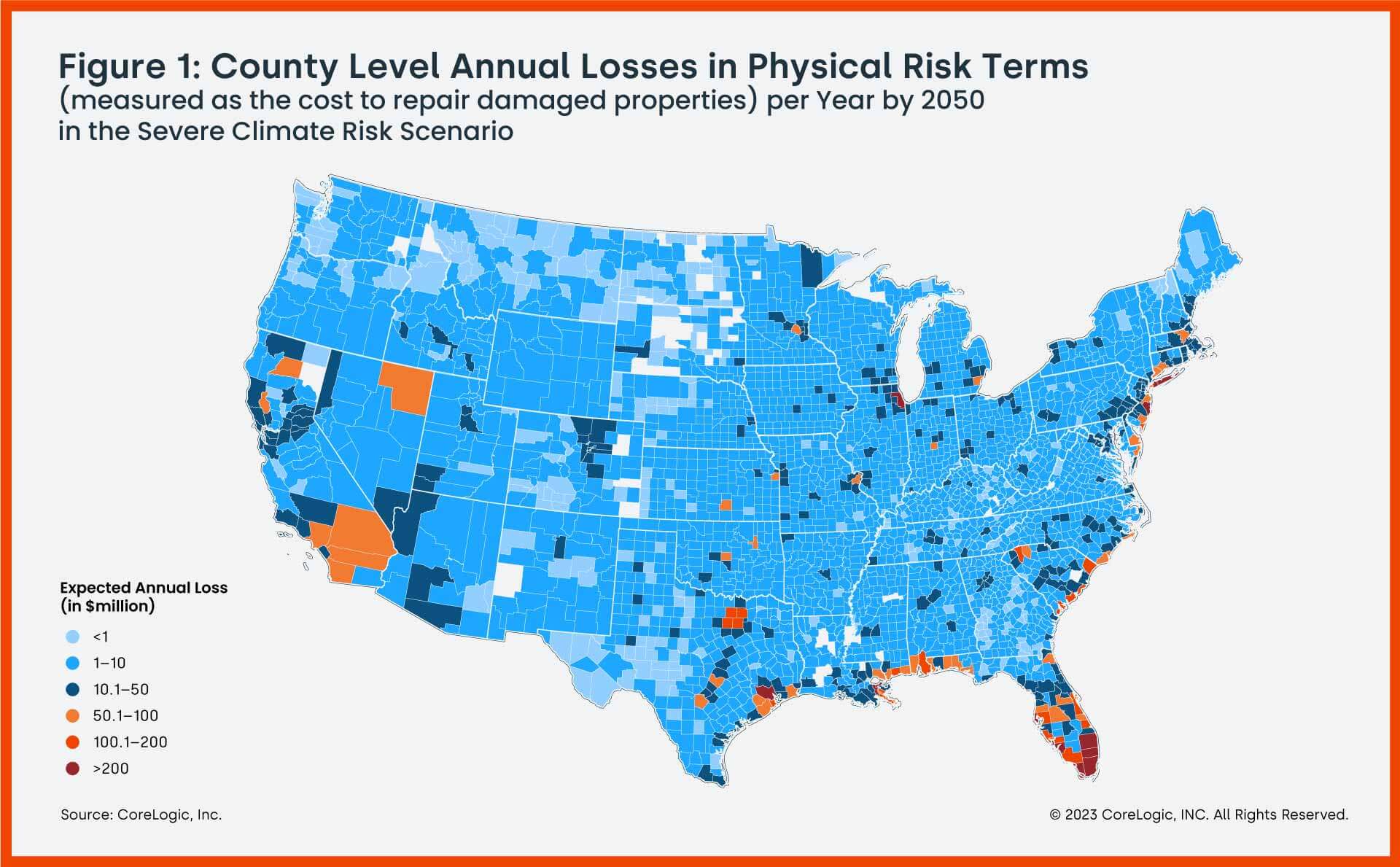Exploring climate change risks on the housing market with CoreLogic Climate Risk Analytics as a guide
Natural disasters damage and destroy millions of properties every year. However, not all areas of the U.S. are equally exposed to these perils, particularly when future climate change scenarios are factored into the equation. While some areas of the country are situated so that they are the safest places to live in the U.S. for natural disasters, other areas are especially vulnerable to climate change.
Hurricane risk is more common in U.S. counties with higher physical risks, and these disasters cause greater losses than other perils. In the U.S., counties exposed to hurricane risk have the largest estimated average annual loss[1] figures when stress tested against the most aggressive climate change scenarios using CoreLogic’s Climate Risk Analytics.
On the current climate change path, nationwide estimated annual losses — a figure that is calculated as the difference between 2023 Average Annual Loss totals, or the cost to repair damaged property, and the estimated values in 2050 — may increase to $23.5 billion per year by 2050 from the base period in severe climate-risk scenario (RCP 8.5).[2]
At a county level, physical risk and its associated losses vary significantly by region. Figure 1 illustrates the impact of a severe climate risk scenario, RCP 8.5, in physical risk terms by U.S. county.

Similarly, Figure 2 lists the top 10 counties with the highest risk of physical loss by future perils events based on CoreLogic’s Climate Risk Analytics. The chart is sorted by estimated annual losses in physical risk terms per year by 2050 under the severe climate risk scenario RCP 8.5. The table also specifies the major perils in these counties.
According to the analysis, Florida’s Miami-Dade County is forecast to have the highest climate change-related risk, with estimated annual losses of $988 million per year by 2050.
Jefferson Parish, Louisiana ranks second, with $476 million in annual losses, followed by Florida’s Palm Beach County where annual loss estimates are $442 million. What makes these counties unique is their exposure to hurricanes and relative lack of risk for wildfires, inland flooding and earthquakes. Counties prone to these other perils don’t make the top 10 list in physical risk terms.

Interestingly, many of the high-risk counties listed in Figure 2 experienced significant price growth in recent years. Though home price growth varied across the top 10 counties, seven of these locations are appreciating faster than the national average, as seen in Figure 3.
Florida metro areas are among the fastest-appreciating U.S. housing markets, recording some of the highest year-over-year growth in March, as measured by the CoreLogic Home Price Index. Miami, which has the largest estimated loss from hurricanes and storm surges, is one the hottest markets in the nation. That metro experienced nearly five times the U.S. home price appreciation rate, posting a 15% annual increase in March 2023 compared with the national growth rate of about 3%.

An unanswered question is whether these counties that are vulnerable to climate change will remain in-demand markets in the face of rising risk. Regardless, clearly understanding both current climate scenarios and future forecasts is essential to developing a mitigation strategy and ensuring community resiliency.
To keep pace with the changing market and environment, CoreLogic’s Climate Risk Analytics solution helps identify these risks at local and regional levels to quantify the impact of various climate change scenarios, helping everyone see the future of the property landscape more clearly.
Learn about the safest places to live in the U.S.
Read the analysis here
[1] This analysis is based on physical losses to properties rather than market value. Thus, the estimates may be lower than the market value analysis.
[2] RCP refers to Representative Concentration Pathways, which are climate simulation-based scenarios. RCP 8.5 is the most aggressive scenario and is characterized by greenhouse-gas emissions increases that drive a temperature increase of about 4.3 Celsius degrees by 2100.
About CoreLogic
Source
Contact
For more information, please email [email protected].
For sales inquiries, please visit https://www.corelogic.com/support/sales-contact/


